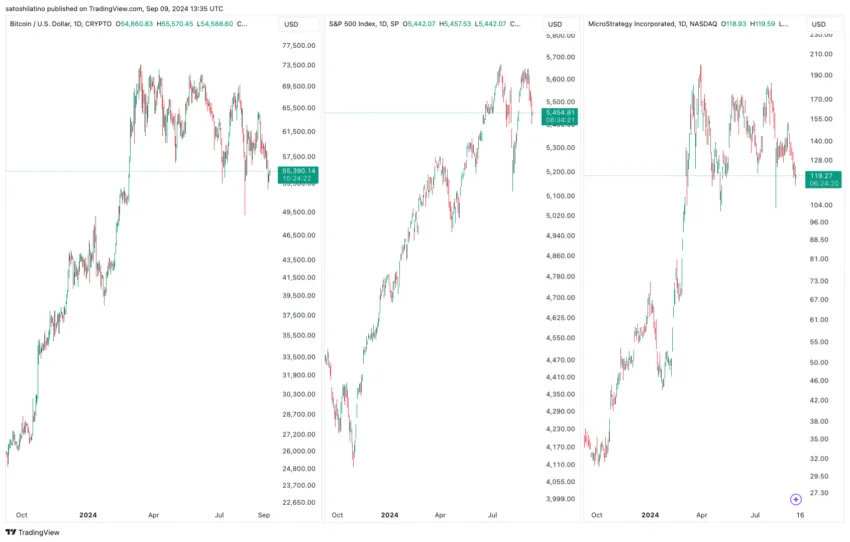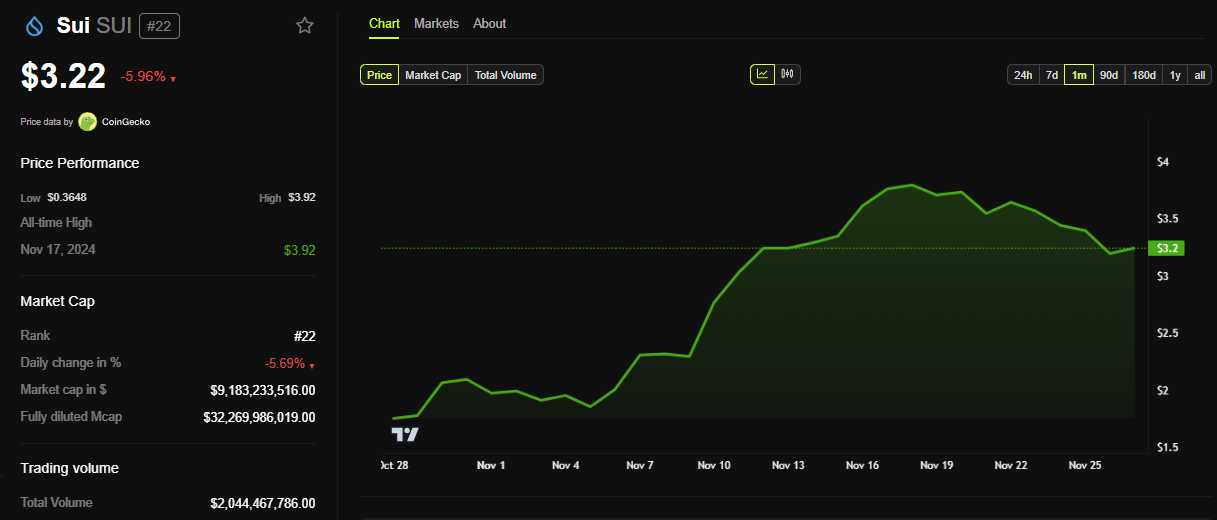Bitcoin
This Stock Beats Bitcoin ETFs in 2024

With the hype surrounding Bitcoin exchange-traded funds, many investors are drawn to the potential of these financial instruments.
However, some analysts suggest there might be a better alternative: MicroStrategy (MSTR) stock. While Bitcoin ETFs offer direct exposure to Bitcoin’s price, MicroStrategy’s unique strategy has consistently outperformed traditional ETF investments, making it a strong contender for those seeking long-term growth.
MSTR Outshines Bitcoin ETFs
MicroStrategy, led by executive chairman Michael Saylor, has been on an aggressive Bitcoin accumulation strategy since 2020. The company has invested over $8.3 billion in Bitcoin, with impressive results.
“Since August 2020, Bitcoin is up 44% per year, while the S&P 500 has grown just 12%. MicroStrategy’s stock has surged by 825%, surpassing even Nvidia, which rose 821%,” Saylor mentioned in an interview.
This performance illustrates the potential of MicroStrategy’s Bitcoin-backed investment approach. Indeed, what sets MicroStrategy apart is its ability to leverage Bitcoin through convertible bonds, offering investors the opportunity to gain exposure to Bitcoin without directly purchasing it.
“We pioneered the Bitcoin-backed bond market, issuing convertible bonds backed by 5x more Bitcoin collateral,” Saylor explained.

This strategy allows the company to generate significant returns while managing Bitcoin’s inherent volatility. In contrast, Bitcoin ETFs provide one-to-one performance tracking with the cryptocurrency but without the potential for leveraging returns.
“With a Bitcoin ETF, you’re getting one-for-one performance and paying a 25 basis point fee, with no yield,” Saylor noted.
Read more: How To Trade a Bitcoin ETF: A Step-by-Step Approach
MicroStrategy’s approach, on the other hand, enables investors to capture both upfront and long-term yields through its bond and equity strategies.
With growing concerns about Bitcoin ETF outflows—over $1.2 billion in recent weeks—investors may want to explore alternative ways to gain exposure to Bitcoin’s growth. MicroStrategy’s approach provides the potential for higher returns, making it a compelling option for those looking beyond ETFs.
Disclaimer
In adherence to the Trust Project guidelines, BeInCrypto is committed to unbiased, transparent reporting. This news article aims to provide accurate, timely information. However, readers are advised to verify facts independently and consult with a professional before making any decisions based on this content. Please note that our Terms and Conditions, Privacy Policy, and Disclaimers have been updated.
Bitcoin
Pantera Capital Bitcoin Fund: $740,000 Prediction by 2028

Pantera Capital has forecasted that Bitcoin could hit $740,000 by April 2028. The firm recently announced a milestone for its Bitcoin Fund, which has achieved a remarkable 1,000x return.
The fund’s lifetime performance now stands at 131,165%, net of all fees and expenses.
Launched in 2013, Pantera’s Bitcoin Fund was among the first investment vehicles in the US to offer exposure to Bitcoin. At that time, Bitcoin was priced at $74. The firm capitalized on this and acquired 2% of the global Bitcoin supply.
However, BTC reached the $99,000 mark earlier this month, which means Pantera’s return on the initial 2013 investment is currently worth over 1,000%.
“Bitcoin dominates cash, electronic fiat money, gold, bearer bonds, large stone discs, etc. It can do all of the things that each of those can. It’s the first global currency since gold. It’s the first borderless payment system ever,” Pantera Capital’s Dan Morehead wrote in the latest statement.
Pantera Capital previously projected Bitcoin’s price to reach $117,000 by 2025.
Meanwhile, Pantera has been exploring new crypto avenues outside of Bitcoin. The firm’s new venture, Pantera Fund V, aims to diversify its portfolio with investments in blockchain assets.
The fund has been looking at private tokens and opportunities such as locked Solana tokens from FTX’s estate. Pantera also raised funds earlier in June to expand its holding in Toncoin.
Bitcoin Facing Correction After Month-long Rally
Despite reaching record highs in November, Bitcoin’s price has dipped 6% in the past few days. Weaker demand among US investors has contributed to this decline, as highlighted by the Coinbase Premium Index.
At the same time, Bitcoin ETFs have seen fluctuating demand. On November 25, ETFs recorded a net outflow of $438.38 million after five consecutive days of inflows that totaled $3.5 billion.

Although Bitcoin’s realized profit dropped from $10.58 million to $1.58 million on Monday, this reduction in selling pressure could indicate room for future price growth.
Moreover, the average holding time for Bitcoin increased by 65% over the past week, suggesting stronger conviction among investors and reinforcing a positive outlook.
While the market remains volatile, Pantera’s long-term prediction reflects confidence in Bitcoin’s growth potential as the leading cryptocurrency continues to attract institutional interest.
Disclaimer
In adherence to the Trust Project guidelines, BeInCrypto is committed to unbiased, transparent reporting. This news article aims to provide accurate, timely information. However, readers are advised to verify facts independently and consult with a professional before making any decisions based on this content. Please note that our Terms and Conditions, Privacy Policy, and Disclaimers have been updated.
Bitcoin
The Future of Decentralized Lending?

According to the World Bank, 1.4 billion adults around the world remain unbanked. The global financial system, despite its unbelievably vast infrastructure, falls short of serving the global population equitably on many counts.
For many, the glittering promise of financial freedom is not merely a matter of surviving the rat race but also a tale of inflation and documentation.
Bitcoin-Backed Credit: A Lifeline for the Unbanked Globally
Millions of people remain underbanked or entirely unbanked due to strict credit requirements, high fees, and limited accessibility. From Palestinian refugees with no proof of citizenship, single women with no employment contract in Egypt, or the countless people facing exorbitant inflation rates of over 120% in Argentina.
During the 2008 financial crisis, countless individuals in the US lost their homes due to predatory lending practices, showcasing the system’s inherent vulnerabilities. Even today, high inflation erodes savings in fiat currencies, leaving consumers with fewer options to preserve their wealth.
Meanwhile, small businesses worldwide face rejection from banks due to rigid creditworthiness standards. One may even argue that money is perhaps the most violent political tool in the weaponry bag of the powers that be.
This gap in accessibility and fairness reveals the need for alternative financial systems. Bitcoin-backed credit offers a viable solution, overcoming both the political agendas and the economic limitations that keep poor people poor.
What Are Bitcoin-Backed Credit Systems?
Bitcoin-backed credit systems allow borrowers to use their BTC holdings as collateral to secure loans without selling their assets. These systems function similarly to secured loans, where a borrower pledges an asset to access liquidity.
If the borrower fails to repay, the lender liquidates the collateral to recover the funds. Unlike traditional loans, these systems do not require credit scores or extensive documentation, making them more accessible to crypto holders.
“High inflation, currency devaluation, and low trust in centralized banks could drive demand for Bitcoin-backed loans. Bitcoin’s stability and decentralized nature make it attractive in volatile economies, and DeFi platforms offer lower barriers and better terms compared to traditional lending,” Kevin Charles, co-founder of The Open Bitcoin Credit Protocol told BeInCrypto in an interview.
The market for Bitcoin-backed credit has grown, with key players like BlockFi, Ledn, Celsius, and Nexo leading the way. These platforms allow users to retain exposure to BTC while accessing fiat or stablecoin liquidity. The simplicity and appeal of these systems have fueled their adoption in recent years, one reason why they have faired peacefully throughout bear markets.
One major advantage of BTC-backed credit is the ability to retain exposure to Bitcoin’s price appreciation. Borrowers can unlock liquidity without selling their BTC, allowing them to benefit from potential long-term gains.
Additionally, Bitcoin-backed loans act as a hedge against inflation by offering an alternative to the ever-devaluing fiat currencies. A crypto holder in Argentina, for example, would be able to secure themselves against their dwindling national currency and even make extra cash.
According to Bankrate, USD now has an inflation rate of 2.4%, which is notably the lowest it has been since February 2021. Meanwhile, BTC has an inflation rate of just 1.7%.

BTC-backed systems also promote financial accessibility. Unlike traditional banks, which require stringent credit checks, Bitcoin-backed credit platforms primarily assess the value of the collateral. This approach opens the door to individuals in regions with limited banking infrastructure, offering a lifeline to the unbanked.
For those who hold true to the ethos of decentralization, global inclusion is the real selling point. Bitcoin-backed credit has the potential to provide financial services to these populations, bridging the gap left by traditional systems. Central banks and global financial institutions remain privy to the whims and shifts of the ever-changing political playground.
In a nation like Lebanon, whose residents primarily transact in USD due to its effectively dead LBP, citizens were barred from withdrawing their own dollars when the central bank faced a dollar shortage crisis. For reference, one USD equals 89,550 LBP. In neighboring Egypt, rumors of impounded USD accounts also began circulating before being denied by central bank officials.
“Bitcoin-backed credit operates on a global, decentralized network, meaning access is not dependent on income, location, or credit history. By using Bitcoin as collateral, anyone holding the asset can access loans without traditional gatekeepers. Early DeFi platforms show increasing adoption in regions with limited banking access, highlighting the potential for financial inclusion,” Charles added.
However, even with all of these advantages, duality is the law of the universe. Bitcoin-backed credit systems are no cure-all solution; they carry significant risks.
The most glaring is Bitcoin’s price volatility. A sudden drop in BTC’s value can trigger margin calls, forcing borrowers to either add collateral or face liquidation. During the crypto market crash in 2022, countless borrowers lost their collateral as prices plummeted. According to Charles, there are ways to mitigate volatility.
“Volatility is managed through over-collateralization and automated liquidations. By requiring more collateral than the loan value, platforms create a buffer against price drops. Additionally, real-time monitoring ensures loans are adjusted to market conditions, maintaining stability even during price crashes,” Charles added.
The Three-Eyed Trojan Horse: Centralization’s Re-emergence
Even so, Bitcoin-backed credit systems have socio-economic implications that warrant examination. The first is that while these platforms democratize access to credit for crypto holders, they risk creating new financial gatekeepers. Wealthy crypto investors, or “crypto whales,” stand to benefit the most, while average users with limited holdings may find themselves excluded.
Whales, or addresses holding more than 100,000 BTC, hold 21% of the total Bitcoin supply. This dynamic means perpetuating wealth concentration within the crypto space as well. If that does happen, we can wave goodbye to the promise of inclusion.

The second concern is traditional financial institutions. They are increasingly infiltrating the Bitcoin-backed credit market through acquisitions and regulatory influence.
Banks like Goldman Sachs and JPMorgan have begun exploring crypto-backed lending, signaling a convergence of decentralized and traditional finance. In November, Bloomberg reported that Goldman Sachs is preparing to launch a new company focused on digital assets. While these developments bring legitimacy, they also raise concerns about co-opting Bitcoin’s decentralized ethos.
Then enters the third and final Trojan horse: government oversight. It presents both opportunities and challenges for Bitcoin-backed credit systems.
Regulation can legitimize these platforms, ensuring consumer protection and stability. However, excessive regulation could stifle innovation and compromise decentralization.
For example, the European Union’s MiCA framework has introduced clarity but also imposed stringent compliance requirements, causing friction within the crypto industry. Binance, the world’s largest crypto exchange by trading volume, had to disable copy trading services for its European users in June after MiCA was announced.
Another issue that may impact accessibility is know-your-customer (KYC) standards, which may hinder those who rely on crypto wallets because they lack sufficient personal documentation. Policymakers often argue that platforms without strict KYC oversight risk assisting criminals in money laundering operations. In 2023, Turkiye even rolled out a new set of crypto laws aimed at tightening up KYC standards.
“We’re witnessing a re-centralization of a system designed to be free. The challenge is finding balance without diluting Bitcoin’s core principles,” Charles posed.
Platforms like Aave and Sovryn exemplify decentralized approaches to Bitcoin-backed credit. These systems rely on smart contracts to automate transactions, reducing the need for intermediaries and ensuring transparency. However, decentralization comes with its own challenges, including scalability, security vulnerabilities, and regulatory gray areas.
Still, success stories exist. Borrowers have used Bitcoin-backed loans to fund businesses, pay medical bills, or navigate economic uncertainty without selling their BTC. Conversely, others have faced significant losses due to liquidation during market downturns, highlighting the high stakes of these systems.
In conclusion, Bitcoin-backed credit represents both a financial revolution and a cautionary tale. Its future hinges on its ability to scale, remain accessible and adhere to Bitcoin’s ethos of decentralization.
As traditional finance enters the space and regulatory frameworks evolve, the challenge will be maintaining the balance between innovation and inclusivity. Whether these systems democratize finance or merely shift the gatekeeping remains to be seen.
Disclaimer
Following the Trust Project guidelines, this feature article presents opinions and perspectives from industry experts or individuals. BeInCrypto is dedicated to transparent reporting, but the views expressed in this article do not necessarily reflect those of BeInCrypto or its staff. Readers should verify information independently and consult with a professional before making decisions based on this content. Please note that our Terms and Conditions, Privacy Policy, and Disclaimers have been updated.
Bitcoin
Programmable BTC Now a Reality

The Sui Foundation has announced a partnership with Babylon Labs, Lombard Protocol, and Cubist to integrate Bitcoin into the Sui ecosystem.
This collaboration will bring programmable Bitcoin functionality to Sui and leverage its high-performance Layer-1 (L1) blockchain to unlock Bitcoin’s $1.8 trillion liquidity for decentralized finance (DeFi).
Unlocking Bitcoin’s Potential on Sui
This development marks an important moment for both Bitcoin (BTC) holders and the broader blockchain community. Bitcoin’s security and liquidity, combined with Sui’s programmability and composability, could redefine how digital assets interact within decentralized systems.
Starting in December, Bitcoin holders will be able to stake their BTC through the Babylon staking protocol. In return, they will receive LBTC, a liquid staking token that Lombard Protocol natively mints on Sui. LBTC, already a cornerstone of Ethereum’s DeFi ecosystem, has surpassed $1 billion in minted assets. It actively serves in lending, borrowing, and trading applications.
This initiative aims to replicate and scale this success on Sui, where LBTC will become a core asset in its DeFi ecosystem. By staking their BTC, users can unlock its value without sacrificing liquidity or security. This aligns with the growing trend of integrating Bitcoin into programmable ecosystems.
“Bringing BTC into Sui is a match made in heaven. Thanks to this collaboration, users from all blockchain ecosystems can come to Sui to participate in a thriving financial ecosystem in which Bitcoin will play a key role,” Jameel Khalfan, Head of Ecosystem Development at the Sui Foundation, said.
Cubist, a novel infrastructure provider, will ensure seamless integration with a strong framework for deposits, staking, minting, and bridging. Babylon Labs and Lombard have already demonstrated the power of Bitcoin liquidity on Ethereum, and now this success is being extended to Sui. By building programmable Bitcoin use cases, Babylon Labs Co-founder and CTO Fisher Yu emphasized their vision.
“Babylon builds native use cases for BTC to bring Bitcoin security and liquidity to decentralized systems. We are excited to make this a reality on Sui,” Yu remarked.
The integration aligns perfectly with Sui’s mission of enhancing the utility of digital assets. By combining Bitcoin’s unparalleled liquidity with Sui’s programmability, this partnership has the potential to drive adoption. It could attract developers, users, and institutional players to the Sui ecosystem.
The Growing Sui Ecosystem
Sui’s ecosystem is advancing, with key developments bolstering its reputation as a top-tier blockchain. Among them is its recent strategic partnership with Franklin Templeton, a global investment firm. The partnership will explore blockchain-based solutions for financial markets. This collaboration reflects Sui’s commitment to integrating traditional finance (TradFi) with blockchain technology.
Similarly, the network’s novel use cases have since come into the limelight. BeInCrypto reported Chirp launched the first decentralized physical infrastructure (DePIN) game on Sui, reflecting its versatility. This play-to-earn model combines blockchain technology with real-world applications, enhancing user engagement.
Nevertheless, while the Sui Foundation’s achievements are commendable, the road has not been without bumps. Recently, Sui experienced a network outage caused by a bug that temporarily disrupted operations.
The foundation acted swiftly to resolve the issue, demonstrating its commitment to reliability and transparency. However, this incident serves as a reminder that even leading blockchain platforms must continually prioritize robustness and scalability.
As Sui taps into Bitcoin’s vast liquidity, its ecosystem is poised for exponential growth. The collaboration with Babylon Labs, Lombard, and Cubist enhances Sui’s DeFi offerings while setting a benchmark for interoperability and innovation across blockchain platforms.

Despite news of this integration, Sui’s powering token, SUI, has been down almost 6% since the Tuesday session opened. BeInCrypto data shows SUI is trading for $3.22 as of this writing.
Disclaimer
In adherence to the Trust Project guidelines, BeInCrypto is committed to unbiased, transparent reporting. This news article aims to provide accurate, timely information. However, readers are advised to verify facts independently and consult with a professional before making any decisions based on this content. Please note that our Terms and Conditions, Privacy Policy, and Disclaimers have been updated.
-

 Altcoin24 hours ago
Altcoin24 hours agoBTC Dips Below $95K, LDO Up 15%
-

 Market20 hours ago
Market20 hours agoXRP Price Eyes Fresh Upside: Can Bulls Deliver?
-

 Bitcoin19 hours ago
Bitcoin19 hours agoProgrammable BTC Now a Reality
-

 Market19 hours ago
Market19 hours agoCan Cardano Bulls Push ADA Price to $2?
-

 Market24 hours ago
Market24 hours agoBitcoin Price Slips Below $95K: Is The Rally Losing Steam?
-

 Altcoin19 hours ago
Altcoin19 hours agoBinance Announces Official Launch of BFUSD
-

 Market18 hours ago
Market18 hours agoBulls Ready for The Next Move?
-

 Market23 hours ago
Market23 hours agoDid It Manipulate Prices Again?
























